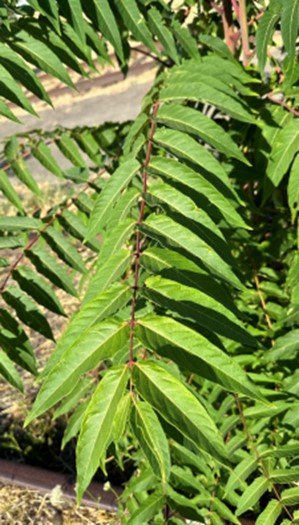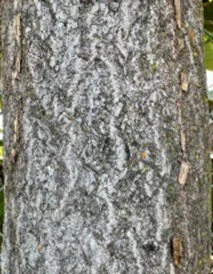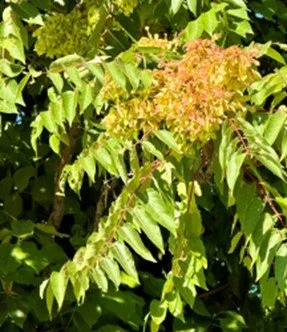Tree of Heaven
Ailanthus altissima
Tree of Heaven is a fast-growing deciduous tree native to eastern Asia.
Leaves have a central stem in which leaflets are arranged opposite to each other on each side (pinnately compound) with a single terminal leaflet.
Leaf length can vary from 1–3’, with 10–40 leaflets each. Leaflet edges lack teeth or serrations. Each leaflet has glandular teeth at its base.
Tree of Heaven can be differentiated from native species (such as ash and black walnut) that have a similar leaf pattern, by its fuzzy, reddish-brown twigs and clusters of light-green seed pods.
Its flowers have a foul odor, and its crushed foliage and twigs can smell like rancid peanut butter or popcorn. Smaller branches break easily to expose a spongy, brown center. Twigs have heart-shaped leaf scars.
The bark is smooth and brownish-green when young, eventually turning light-brown to grey, with a texture resembling cantaloupe skin.
Seeds form in a large, papery winged capsule (samara) that enables them to sail away in the wind.
Control considerations
A Tree of Heaven is either male or female; females produce copious amounts of seed. Sprouts as young as two years old are capable of producing seed.
A cut or injured tree may also send up dozens of stump and root sprouts. Cutting them back will temporarily help reduce fuel loads and the tree’s ability to make seeds.
The most effective control is to pull seedlings by hand before a taproot develops.
Tree of Heaven produces allelopathic chemicals that prevents establishment of other plants, impacting the native ecosystem in that area.
Bottom left: Pinnate leaf with many opposite leaflets.
Bottom left center: Heart- or v-shaped leaf scar.
Bottom right center: Bark with cantaloupe-skin texture.
Bottom right: Tree of Heaven samaras (seeds with papery wings).
Print this ID Card
Learn more about Trees of Heaven from the California Invasive Plant Council





